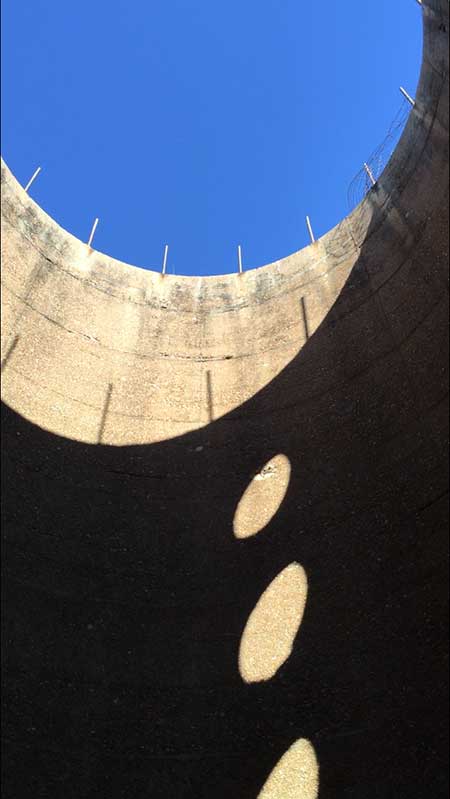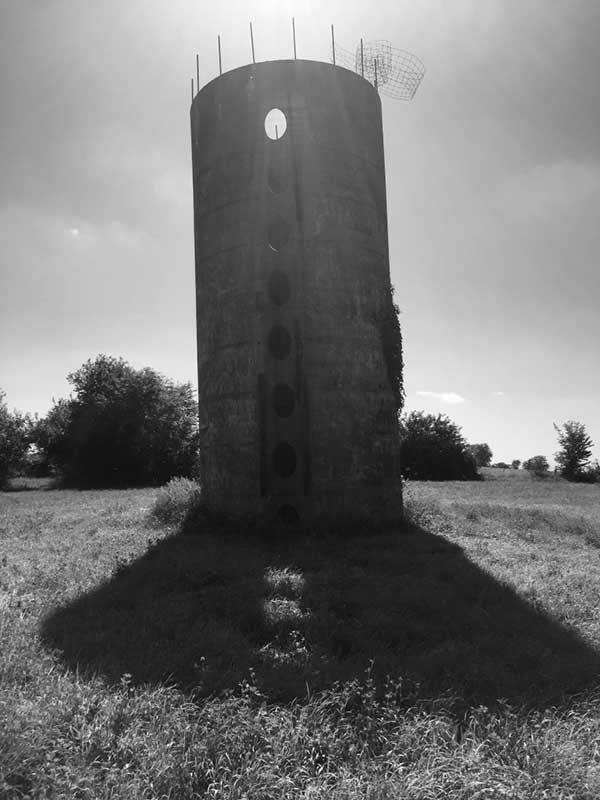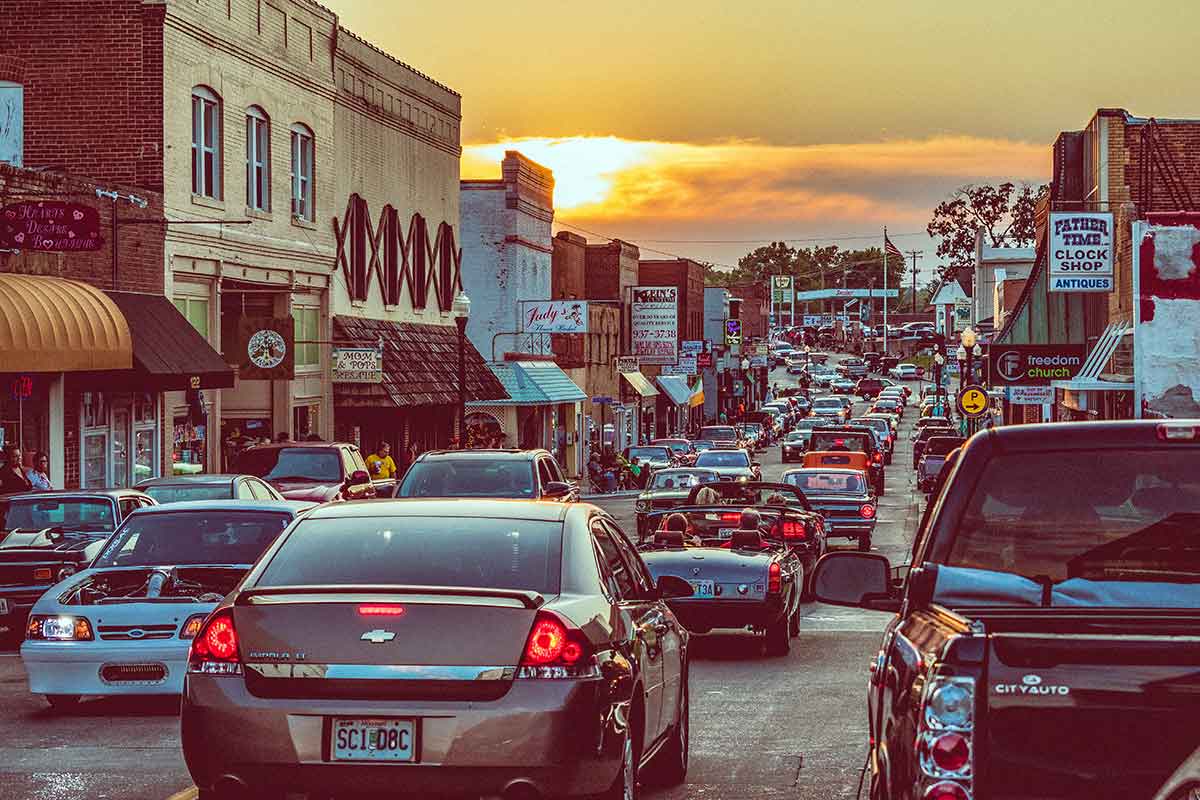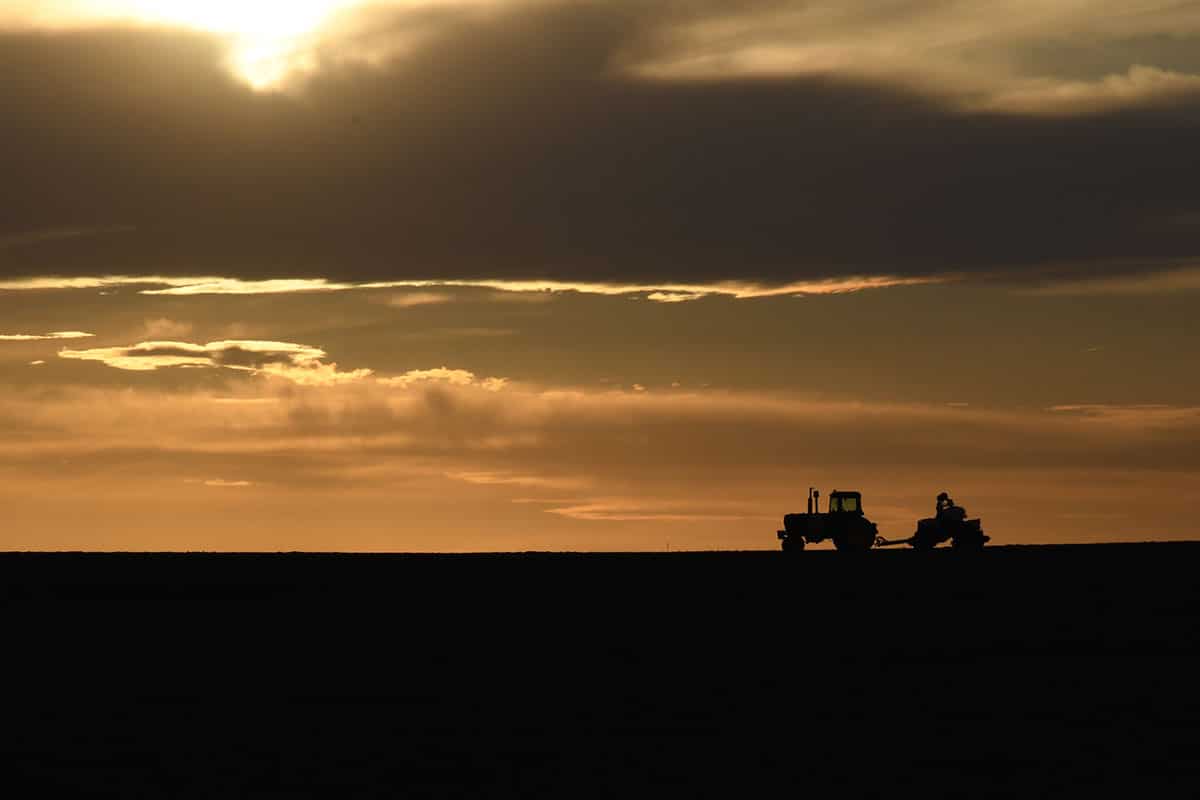Abandoned Johnson County silo stands for beauty,
history, harvest, geometry … and indifference.
An old roofless silo stands in the south field of my Missouri hay farm. While the exact circumstances are a mystery, neighbors say the silo lost its roof over forty years ago. Nothing is left of it now except for the bare ends of rebar exposed on top.
Standing inside, you can look up and see a round slice of sky. When you view the silo from the sky above, using a drone or the Google Maps satellite feature, you can peer down into it—into its concentric depths of time.
Without the roof or the utility of protecting and storing grain, the silo has fallen into stark ruin. It leans hard to the south. Cracks, stains, and ivy invade the pebble stone aggregate concrete wall. A few remaining weathered boards are bolted vertically alongside the eight oval portals. The boards once supported—we assume—eight hatch covers that one could open to tap into the stored grain using a chute or auger.
The eight openings now freely direct sunlight and moonlight in ways that transform this monolith into an everchanging show of illumination.
To begin with, the silo faces east so precisely that during the week of the vernal equinox, sunrise projects its light straight through those chute holes to the exact middle of the backside interior wall. A near perfect spine of lights appears, climbing forty feet to the top.
The alignment and light projections make for fun speculation. Did my circa 1920–1930 predecessors-in-interest who installed the silo believe that Stonehenge had an astronomically oriented alignment and devised another alignment in this hayfield? Was March 23 a day of meaning for them? Inside the silo on that morning, you can stand near the back wall and see the first starbursts of sunrise with near perfect framing in the second portal from the ground.
I say near perfect because of the silo’s aforementioned lean. It’s my own Tower of Pisa problem, caused by an improper initial installment into the clay foundation or from reckless grain storage habits or from just being so damned old. Like Pisa, the silo’s base will eventually have to be stabilized. (And my budget destabilized.)

Fescue, timothy grass, clover, and wildflowers grow thick on the south field through most of spring until July’s mowing and baling reveals the ground’s potential as a surface for imagery from the silo. When the sun then rises and moves a tad west of overhead, light casts down into the silo and angles through the old chute holes and onto the ground. The silo’s inverted negative image develops and fades within an hour. When a full moon follows the same ecliptic path that night and locks into the overhead position, it creates a more ghostly silhouette.
During moonless nights in 2016, my buddy, Wade, photographed the Milky Way with the silo in the foreground. His long exposures revealed thousands of stars inside a dense and colorful Milky Way trailing over the silo. Against that backdrop of cosmological age, even the silo in its decline is a new thing in the world.
Buzzards often perch along the top, sometimes as many as a dozen ringed around it. Coyotes have ventured inside, leaving prints and scat along with the bones of small prey. A pair of beagles—rabbit-hunting sisters—habitually stick their noses inside to suggest the silo may have been the refuge for a rabbit during one of their past hunts.
Each fall since 2015, I have hosted a small private music and arts festival at the farm. Along with the silo, the forty-three-acre farm has a cabin, two fishing ponds, wooded areas, and a spring. Add a large tent, stage, dance floor, and fields of hay bales, and the property makes a great venue for such an event. I conceived it as our own private Coachella or Stagecoach festival and eventually dubbed it “Silofest.” Friends, family, musicians, and artists come out for a weekend of live music, photography, outdoor sculptures, homebrews, and getting our country on.
Nearly every Silofester has made an early morning trek from their tent at sunrise or a late afternoon walk at sunset with a beer to the south field where sits the festival’s forty-foot-tall eponym. Once upon a time, those pilgrimages were limited to the outside of the silo because a pool of sludgy water filled the structure up to the bottom of the first hole. One could poke their head through the first or second hole and take in the light projections or look up at the sky.
Worth the trip, but I knew visitors were still missing out.
My friends sang an aria from La Boheme to test the silo’s reverb. I closed my eyes and experienced the sublime, an aural illusion of being inside a cathedral or opera house
During long dry periods, I had been able to walk into the silo and experience its ethereal space, light, and sound. Years before this pandemic, another buddy, Garrett, brought in a Bluetooth speaker and played the electronica band Teargas & Plateglass, including their track, Plague Burial. The silo is an echo chamber, and Plague Burial there reached even deeper and darker levels of ambient. A year before that, my talented friends, David and Kathy, sang an aria from La Boheme to test the silo’s reverb. I closed my eyes and experienced the sublime, an aural illusion of being inside a cathedral or opera house.

The artist James Turrell creates skypaces — rooms and structures with openings that frame the sky. Turrell has said that with his work he is interested in the sense of a presence with space and also in showing us the limits and wonder of our perception. His 2017 exhibition in Los Angeles and the music experiences described above inspired me to try to open up the silo’s potential.
To keep its earthen floor drained and dry, I bought fifty feet of plastic, corrugated, perforated tubing—a drainage pipe. The good fortune of a month of dry summer weather occurred. I went to work, digging a hole and trench system for the pipe, to begin inside the silo, go under its north wall, and then out to the hayfield.
Some hours even passed under a buzzard’s expectant and longing stare.
Nearly a century ago, if the area “historians” have it right, builders delivered the silo’s stave cylinder to the property, straightened it up, and jammed it six feet into the ground, backfilling and infilling its base with hard, wet clay to hold it up. That clay slowed my drainage project down in a hurry. Days of grueling work ensued inside the silo. Some hours even passed under a buzzard’s expectant and longing stare. I broke a shovel and a trowel in the clay. Gave up at least twice.
During that quality dawn-till-dusk man-and-silo bonding time, I noticed that almost as soon as I thought I had perceived and absorbed the space around me, new lighting would change it into a different world. Bearing out Turrell.
I did finally get under the silo and break through to the other side. With the tubing installed, the silo has stayed dry ever since, and I’ve added gravel, a fire pit, and even a couple of mirrors that reflect more light.
During Silofest 2017, my friends Wendy and Ken loaned me a massive projector that could display 15,000 lumens with high resolution in order to project photographs onto the silo’s outside wall. It took two men and some grunting to lift the 90-pound projector and protective frame out of a truck and move it into position in the hayfield. The projector’s built-in computer used a geometric algorithm to account for the surface’s curvature.
While such geometry should have been beyond us there drinking in the dark, we did manage to get it going. Among the images we projected in forty-foot tall fashion were of Garrett and his girlfriend, Nicole, scaling a mountain (they appeared to be scaling the silo instead); Wade’s beautiful daughter Evelyn; and a shimmering, iridescent bluegill that had just been pulled out of the pond into the sunlight with the silo in the photograph’s background.
The silo sits impassively through Silofest and all the attention paid to it, and then sits with equal impassiveness through the rest of the seasons in abandoned isolation.
For that weekend, the silo is one of the most well attended, photographed, and painted silos in all of Johnson County. Otherwise, it is remote and alone. It takes a couple of long gravel roads and then a gravel drive to get back to it. No trace of an original barn exists, I don’t live on the property, and even in relatively busy non-Covid years, I only get to it about seven times a year. Thus, the silo sits impassively through Silofest and all the attention paid to it, and then sits with equal impassiveness through the rest of the seasons in abandoned isolation.
In his poem, Grief and Sorrow, William Wordsworth called Stonehenge an “inmate of lonesome Nature’s endless year.” He wrote that it was “proud to hint yet keep Thy secrets.” Those verses ring true of this silo. Even with commerce no longer occurring about it and stripped of its former utility, the structure has become a landmark.
But of what?
In other words, what does it stand for?
Each year, I discover more answers to this question. Because of the pandemic, this year’s Silofest was moved online. Fourteen musicians, poets, and readers performed live from Kansas City, Ireland, and Los Angeles. I joined in not from the farm and Missouri’s autumnal glory, but from my house in Culver City, California, through a laptop on the back patio, socially distanced from friends, and wearing a bandana as mask.
During the festival, near the beginning of that three-hour Zoom event, my co-host Phil asked me, “So what’s the deal with that silo?”
“It’s a beauty,” I said, and then tried to sum up its history, mystery, and meaning.
For me, beauty is one thing it stands for. Especially at sunrise, sunset, or under the Milky Way. The silo stands for beauty along with history, harvest, geometry, mystery, and indifference.
Indifference.
In Grief and Sorrow, Wordsworth referred to a “ravenous plague” that would “unman the firmest heart to hear/All perished — all in one remorseless year.” The silo is indifferent to that and to us and what we are going through. But when we look upon its stillness, with sky and time turning above, our own minds are turned. And as it leans to the south with its cracks, with its rack and ruin, the silo reminds us that it and we will not last.
Gary Rhoades is a civil rights attorney and writer who is bicoastal, splitting time between home in Los Angeles and his catfish and bass ponds in Missouri. This article originally appeared on Gary’s blog on medium.com.
Related Posts
Revitalizing Missouri Downtowns
Here’s how Missourians are working together to revitalize downtowns across the state.
This is Our Missouri
A photo project helps commemorate the bicentennial.



